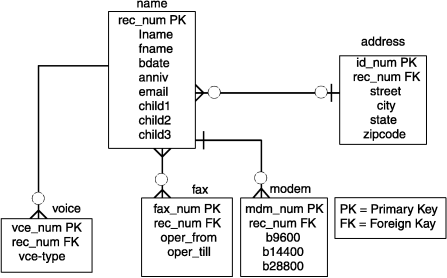Add keys to the telephone directory diagram
The following figure shows the initial choices of primary and foreign keys. This diagram reflects some important decisions.
For the name table, the primary key rec_num is selected. The data type for rec_num is SERIAL. The values for rec_num are system generated. If you look at the other columns (or attributes) in the name table, you see that the data types that are associated with the columns are mostly character-based. None of these columns alone is a good candidate for a primary key. If you combine elements of the table into a composite key, you create a cumbersome key. The SERIAL data type gives you a key that you can also use to join other tables to the name table.
The voice, fax, modem, and address tables are each joined to name through the rec_num key.
For the voice, fax, and modem tables the telephone numbers are used as primary keys. The address table contains a special column (id_num) that serves no other purpose than to act as a primary key. This is done because if id_num did not exist then all of the other columns would have to be used together as a composite key in order to guarantee that no duplicate primary keys existed. Using all of the columns as a primary key would be very inefficient and confusing.
